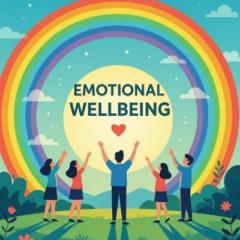2d (edited) • What Helps?
Becoming the Architect of Your Own Happiness:
Hello, wonderful members of the Emotional Wellbeing community! As a motivational coach, speaker, and writer, I'm thrilled to dive into a profound piece of wisdom that's been circulating in self-development circles. Today, I'm analysing an inspiring quote from an attached image shared in our community: "Perhaps the biggest mistake I made in the past was that I believed love was about finding the right person. In reality, love is about becoming the right person. Don't look for the person you want to spend your life with. Become the person you want to spend your life with."
This quote, presented on a simple, textured background reminiscent of an old notebook page, captures a shift in perspective that's essential for emotional well-being. It's not attributed to a specific author in the image, but its message echoes timeless philosophies from thinkers like Carl Jung and modern self-help icons such as Brené Brown.
At its core, it challenges the romanticised notion of love as a quest for "the one" and redirects our energy inward. Love—and by extension, happiness—isn't a treasure hunt; it's a personal evolution. In this article, I'll break down the quote's deeper meaning and share actionable strategies to help you cultivate emotional balance and lasting happiness by becoming that "right person" for yourself.
Strategies for Becoming the Person You Want to Spend Your Life With
To translate this wisdom into practice, here are five evidence-based strategies tailored for our community. These are designed to build emotional balance by nurturing self-awareness, resilience, and joy. Implement them gradually, perhaps journaling your progress in our Skool discussions for accountability and support.
1. Cultivate Self-Awareness Through Daily Reflection
Start by understanding who you truly are and who you aspire to be. Emotional balance begins with introspection.
- Action Step: Set aside 10 minutes each evening for a "self-audit." Ask: What qualities do I admire in others? (E.g., patience, creativity.) How can I embody them today? Use a simple notebook.
- Why It Works: This practice reduces reactive emotions and builds mindfulness, as shown in studies on reflective journaling from the Journal of Personality and Social Psychology.
- Happiness Boost: You'll feel more aligned, reducing the anxiety of unmet expectations in relationships.
2. Build Emotional Resilience with Habit Stacking
Becoming "the right person" means handling life's ups and downs gracefully. Resilience isn't innate—it's built.
- Action Step: Stack small habits onto existing routines. For example, after brushing your teeth, do a 5-minute breathing exercise (like 4-7-8 breathing: inhale for 4, hold for 7, exhale for 8). Gradually add gratitude listing: Note three things you're proud of about yourself.
- Why It Works: Habit stacking, popularized by James Clear in Atomic Habits, leverages neuroplasticity to rewire your brain for positivity.
- Happiness Boost: Over time, this creates a buffer against stress, leading to more stable moods and deeper self-compassion.
3. Foster Authentic Connections by Prioritizing Self-Care
The quote reminds us that healthy love starts with self-love. Neglecting your needs keeps you from being fully present for others.
- Action Step: Create a "self-date" ritual weekly—something you'd enjoy with your ideal partner, like a solo hike, reading a book, or cooking a favorite meal. Track how it shifts your energy.
- Why It Works: Self-care combats burnout and builds emotional independence, aligning with attachment theory's secure base concept.
- Happiness Boost: You'll attract relationships that mirror your self-respect, reducing feelings of loneliness and enhancing overall joy.
4. Embrace Continuous Learning and Growth Mindset
Happiness thrives on progress. View challenges as opportunities to evolve.
- Action Step: Dedicate time to skill-building that excites you—online courses on Skool, podcasts on emotional intelligence, or hobbies like painting. Set micro-goals, like reading one chapter a week from books such as The Gifts of Imperfection by Brené Brown.
- Why It Works: Carol Dweck's growth mindset research shows that seeing abilities as developable leads to greater perseverance and satisfaction.
- Happiness Boost: Achieving personal milestones releases dopamine, creating a cycle of motivation and emotional equilibrium.
5. Practice Radical Acceptance and Forgiveness
To become the person you want to be with, release past baggage that hinders balance.
- Action Step: Use affirmations like "I am worthy as I am" during meditation. For forgiveness, write letters (unsent) to past hurts, then burn or delete them symbolically.
- Why It Works: Acceptance therapies, like ACT (Acceptance and Commitment Therapy), prove that letting go reduces rumination and frees energy for growth.
- Happiness Boost: This clears emotional clutter, allowing space for genuine peace and self-love.
Wrapping Up: Your Journey to Emotional Harmony
In analysing this powerful quote, we see it's more than relationship advice—it's a manifesto for emotional wellbeing. By shifting from seeking to becoming, you take control of your happiness narrative. Remember, community members: You're not broken; you're becoming. Share your experiences in the comments—how has focusing inward changed your life? Let's support each other on this path.
If you're ready to dive deeper, join our upcoming workshop on "Self-Love Strategies" right here on Skool. Until then, be the love you wish to see in the world.
With encouragement and warmth, [Your Name]
1
0 comments
powered by

skool.com/emotional-wellbeing-service-1635
How to Achieve Emotional Balance and Harmony that strengthens your resilience and moves you forward from a place of surviving to thriving.
Suggested communities
Powered by
